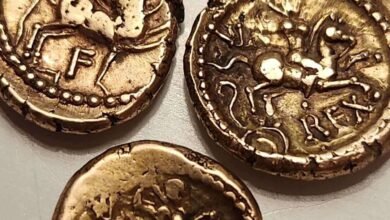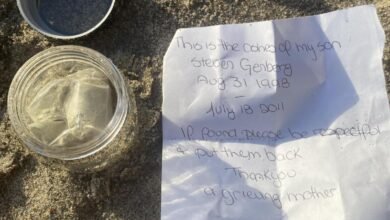350-year-old buried treasure found on farm in Germany

Construction workers in Wettin stumbled upon a collection of 285 coins that had been buried in the 1650s and then forgotten, archaeologists said and photos show.
Photo by the Old Town Association Wettin eV and Frank Dobberstein
As construction workers dug into the tan soil of a historic farm in southern Germany, their project quickly took on a different meaning. They stumbled upon a pile of silver artifacts — and found buried treasure from 350 years ago.
[–>
Construction crews began digging in the courtyard of a farmstead in Wettin last summer to install a new sewer line, the State Office for Monument Preservation and Archaeology in Saxony-Anhalt said in a May 29 news release.
[–>
As they dug near the gate, the workers unearthed a compact block of coins buried just over a foot down, officials said. They alerted archaeologists who excavated the find.
[–>
Archaeologists found an assortment of 285 silver coins dating from 1499 to 1652, officials said. The coins were likely placed in a now-gone bag and hidden in the 1650s.
[–>

[–>
A photo shows the 350-year-old treasure. The dusty, blue-green coins appear densely packed and piled on top of each other.
[–>
Archaeologists identified the collection as a variety of regional German and foreign coins, officials said. Some of the artifacts originated in Austria, Switzerland and Italy. Many are rare finds for the Wettin area.
[–>

The coin collection was likely accumulated over a 150-year span by a merchant or merchant family, and worth a considerable amount during the 1650s, officials said.
[–>
Archaeologists suspect the 350-year-old stash might be linked to Johann Dondorf, a wealthy mayor of Wettin who owned the farmhouse at the time the coins were buried.
[–>

Wettin is a small town in the state of Saxony-Anhalt and a roughly 120-mile drive southwest from Berlin.
[–>
Google Translate was used to translate the news release from the State Office for Monument Preservation and Archaeology in Saxony-Anhalt.
[–>[–>[–>




